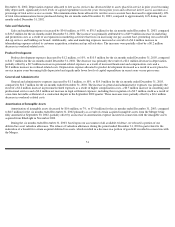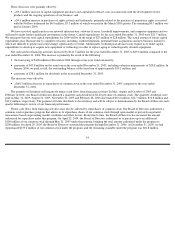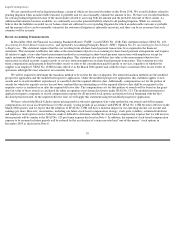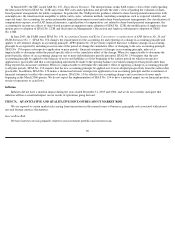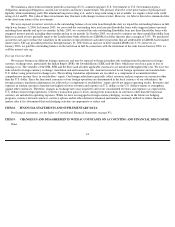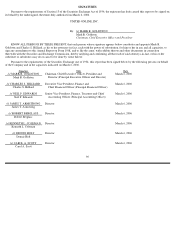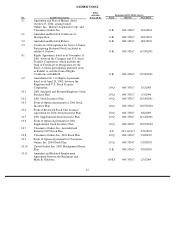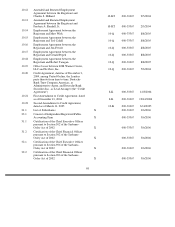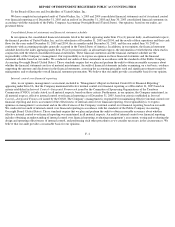Classmates.com 2005 Annual Report Download - page 62
Download and view the complete annual report
Please find page 62 of the 2005 Classmates.com annual report below. You can navigate through the pages in the report by either clicking on the pages listed below, or by using the keyword search tool below to find specific information within the annual report.
We maintain a short-term investment portfolio consisting of U.S. commercial paper, U.S. Government or U.S. Government Agency
obligations, municipal obligations, auction rate securities and money market funds. Our primary objective is the preservation of principal and
liquidity while maximizing yield. The minimum long-term rating is A, and if a long-term rating is not available, we require a short-term credit
rating of A1 and P1. The value of these investments may fluctuate with changes in interest rates. However, we believe this risk is immaterial due
to the short-term nature of the investments.
We were exposed to interest rate risk on the outstanding balance of our term loan through the date we repaid the outstanding balance in full,
which was January 3, 2006. In January 2005, we converted the outstanding base rate loan into Eurodollar loans with staggered interest periods
including three months and up to six months. In July 2005, we converted the only outstanding Eurodollar loan into three Eurodollar loans with
staggered interest periods including three months and up to six months. In October 2005, we elected to continue our three month Eurodollar loan.
Interest accrued at rates generally equal to the London inter-bank offered rate (LIBOR) for dollar deposits plus a margin of 3.0%. We purchased
an interest-rate cap to reduce the variability in the amount of expected future cash interest payments that are attributable to LIBOR-based market
interest rates. The cap provided protection through January 31, 2007 from an increase in three month LIBOR over 3.5%; however, in
January 2006, we paid the outstanding balance on the term loan in full. In connection with the retirement of the term loan in January 2006, we
sold the interest rate cap.
Foreign Currency Risk
We transact business in different foreign currencies and may be exposed to financial market risk resulting from fluctuations in foreign
currency exchange rates, particularly the Indian Rupee (INR), the Swedish Krona (SEK) and the Euro, which may result in a gain or loss of
earnings to us. The volatility of the INR, SEK and the Euro (and all other applicable currencies) are monitored throughout the year. We face two
risks related to foreign currency exchange: translation risk and transaction risk. Amounts invested in our foreign operations are translated into
U.S. dollars using period-end exchange rates. The resulting translation adjustments are recorded as a component of accumulated other
comprehensive income (loss) in stockholders’ equity. Our foreign subsidiaries generally collect revenues and pay expenses in currencies other
than the U.S. dollar. Since the functional currencies of our foreign operations are denominated in the local currency of our subsidiaries, the
foreign currency translation adjustments are reflected as a component of stockholders’ equity and do not impact operating results. Revenues and
expenses in foreign currencies translate into higher or lower revenues and expenses in U.S. dollars as the U.S. dollar weakens or strengthens
against other currencies. Therefore, changes in exchange rates may negatively affect our consolidated revenues and expenses (as expressed in
U.S. dollars) from foreign operations. Currency transaction gains or losses arising from transactions in currencies other than the functional
currency are included in operating expenses. While we have not engaged in foreign currency hedging, we may in the future use hedging
programs, currency forward contracts, currency options and/or other derivative financial instruments commonly utilized to reduce financial
market risks if it is determined that such hedging activities are appropriate to reduce risk.
ITEM 8.
FINANCIAL STATEMENTS AND SUPPLEMENTARY DATA
For financial statements, see the Index to Consolidated Financial Statements on page F-1.
ITEM 9.
CHANGES IN AND DISAGREEMENTS WITH ACCOUNTANTS ON ACCOUNTING AND FINANCIAL DISCLOSURE
None.
61


